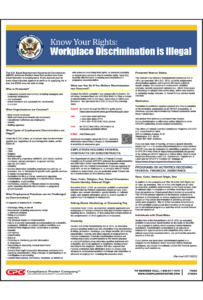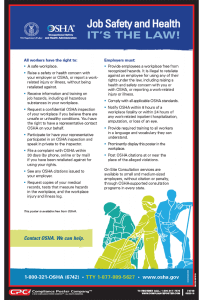
Those who hoped that the new administration would bring “certainty” for employers are probably a bit disappointed right now, as the most recent move from the federal government raises more questions about protections for transgender employees under federal law. On Wednesday, the U.S. Department of Justice (DOJ) released a memo which resets federal policy on the scope of sex discrimination protections established by Title VII of the Civil Rights Act of 1964.
In the newly-released memo, Attorney General Jeff Sessions states that DOJ’s position in enforcement and litigation matters is currently that “Title VII’s prohibition on sex discrimination encompasses discrimination between men and women but does not encompass discrimination based on gender identity per se, including transgender status.” The memo specifically references the assignment of “sex-specific bathrooms,” a highly charged issue in recent years, as an example of the kinds of employment practices which “do not impose burdens on similarly situated members of each sex,” and which Title VII therefore “is not properly construed to proscribe.”
This new position reverses a policy established in 2014 under former Attorney General Eric Holder. In his memo, Holder argued that “The most straightforward reading of Title VII is that discrimination ‘because of … sex’ includes discrimination because of an employee’s gender identification as a member of a particular sex, or because the employee is transitioning, or has transitioned, to another sex.” He expressed hope that the DOJ’s position would “foster consistent treatment of claimants throughout the government” and aid in the protection of civil rights for all Americans.
UNCERTAINTY REMAINS AS EEOC POLICIES PERSIST
 Consistency is once again an issue, as the 2017 policy now places DOJ at odds with the federal agency which enforces most of Title VII’s employment protections, the Equal Employment Opportunity Commission (EEOC). EEOC is responsible for enforcement actions against private sector employers and providing guidance to the federal sector, while the DOJ’s Civil Rights Division handles Title VII violations committed by state and local government employers.
Consistency is once again an issue, as the 2017 policy now places DOJ at odds with the federal agency which enforces most of Title VII’s employment protections, the Equal Employment Opportunity Commission (EEOC). EEOC is responsible for enforcement actions against private sector employers and providing guidance to the federal sector, while the DOJ’s Civil Rights Division handles Title VII violations committed by state and local government employers.
Currently, EEOC “interprets and enforces Title VII’s prohibition of sex discrimination as forbidding any employment discrimination based on gender identity or sexual orientation.” Most recently, on September 29, 2017, EEOC filed a lawsuit on the basis that a private employer violated Title VII when it retracted a job offer and refused to hire an applicant upon discovering that he was a transgender man.
EEOC and DOJ have previously clashed on the question of whether the prohibition on employment discrimination “because of sex” also encompasses discrimination based on sexual orientation. In July of 2017, DOJ filed an unsolicited amicus brief with the 2nd U.S. Circuit Court of Appeals, which is currently considering an EEOC case regarding sexual orientation discrimination.
DOJ’s brief representing the United States claimed that it has been “settled for decades” that Title VII does not extend to sexual orientation and emphasized that “the EEOC is not speaking for the United States.” As 2nd Circuit Judge Rosemary Pooler pointed out, however, it’s “a little bit awkward” that the federal government is arguing against itself in court.
OTHER (OSHA) CONSIDERATIONS
 Besides EEOC’s current position on gender identity discrimination, private employers should also keep in mind that the Occupational Safety and Health Administration (OSHA) has released its own guide to best practices on restroom access for transgender workers which advises employers to allow employees to use facilities that correspond with their gender identity.
Besides EEOC’s current position on gender identity discrimination, private employers should also keep in mind that the Occupational Safety and Health Administration (OSHA) has released its own guide to best practices on restroom access for transgender workers which advises employers to allow employees to use facilities that correspond with their gender identity.
OSHA’s Sanitation Standard requires employers to protect employees from the adverse health effects which can result from the lack of prompt access to sanitary and appropriate toilet facilities, such as urinary tract infections or bowel and bladder problems. Employers are also barred from placing “unreasonable restrictions” on employee’s use of toilet facilities.
While OSHA regulations do not address the issue of whether it is unreasonable to restrict a transgender employee from accessing the bathroom which corresponds with his or her gender identity, OSHA’s best practices guide points out that such a restriction may result in “employees avoiding using bathrooms entirely while at work, which can lead to potentially serious physical injury or illness.” The guide also cautions that employees may fear for their physical safety if they are required to use a bathroom facility which is inconsistent with their gender identity or segregated from other workers.
AND THEN THERE’S THE ADA
A recent decision from a federal court suggests that some transgender workers may be protected from employment discrimination under the Americans with Disabilities Act of 1990 (ADA). Although the ADA’s definition of disability explicitly excludes “gender identity disorders not resulting from physical impairments,” the evolution of psychological positions towards transgender identities has resulted in statutory ambiguity.
During the period in which the ADA became law, the Diagnostic and Statistical Manual of Mental Disorders (DSM), which provides standardized definitions and diagnostic criteria for mental illnesses, defined Gender Identity Disorder as consisting of feelings of incongruity between a person’s gender identity and their sex. Essentially, the “disorder” was considered to be the experience of being a transgender individual.
In 2013, the DSM revised the diagnostic criteria for Gender Identity Disorder, now referred to as Gender Dysphoria. Under the current definition, a necessary and definitive aspect of the condition is clinically significant distress caused by either the incongruity itself or by significant impact on quality of life. In his decision on Blatt v. Cabela’s, United States District Judge Joseph F. Leeson, Jr. pointed out that the evolving standard makes it “reasonably possible” to read the ADA’s definition of “gender identity disorder” as referring to “only the condition of identifying with a different gender, not to encompass (and therefore exclude from ADA protection) a condition like Blatt’s gender dysphoria, which… is characterized by clinically significant stress and other impairments that may be disabling.”
Plaintiff Blatt accepted a settlement from her former employer in September, so this particular case will not move forward. The success of the claim, however, suggests that we may see similar cases in the future.
WHAT’S NEXT FOR TITLE VII?
Although many wish to see the matter “settled” in one way or another, the widening conflict between DOJ’s position and that of the EEOC means that the scope of Title VII’s protections against sex discrimination – in regards to both gender identity and sexual orientation – are likely to be under debate for some time to come.
Federal courts have also failed to settle the question. Most appellate courts, including a recent decision from the 11th Circuit, have concluded that discrimination due to an employee’s transgender status is sex discrimination under Title VII. (Notably, the DOJ memo cites the dissenting opinion from a 7th Circuit decision when discussing the legal case for the new policy.)
Until this year there was a general consensus that Title VII does not cover sexual orientation, but courts have started to split with a recent 7th Circuit decision affirming that Title VII does cover sexual orientation discrimination. Judges from the 2nd Circuit, discussed above, have also indicated some approval of this interpretation. The Supreme Court has yet to address the question in regards to either gender identity or sexual orientation.
Employers also, of course, need to consider state and local labor law. Lacking unambiguous federal protections, many state and local governments have stepped in to increase employment security for LGBT workers. 20 states have passed statutes which prohibit employment discrimination on the basis of both gender identity and sexual orientation, while two more offer protections only on the basis of sexual orientation. Municipalities in states without these protections have also started to approve anti-discrimination ordinances, although states are increasingly pushing back with laws which prohibit local governments from addressing aspects of employment law such as discrimination.
Employers operating in multiple states, particularly those facing federal uncertainty rather than state surety, should consult with legal council to ensure their compliance and mitigate legal risk in their employment policies. You can also subscribe to this blog or follow us on social media to keep up with the latest in state and federal labor law.

